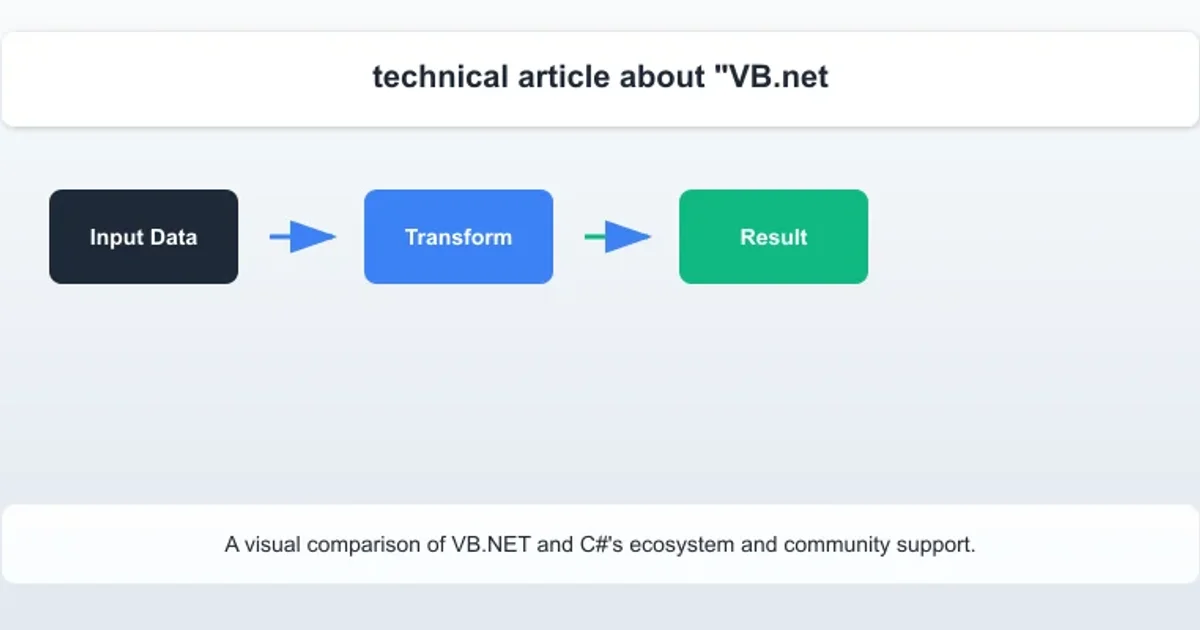VB.net application in "Real World" software?
Categories:
VB.NET in the Real World: A Comprehensive Look at its Modern Relevance

Explore the current landscape of VB.NET, its strengths, weaknesses, and where it continues to thrive in enterprise and niche applications.
VB.NET, a multi-paradigm, object-oriented programming language implemented on the .NET Framework, has a long and storied history. Evolving from the widely popular Visual Basic 6, it was designed to bring the ease of VB development into the modern, object-oriented world of .NET. While often overshadowed by C# in recent years, VB.NET continues to power a significant number of applications globally. This article delves into where VB.NET stands today, its practical applications, and why it remains a relevant choice for certain development scenarios.
The Enduring Presence of VB.NET
Despite perceptions, VB.NET is far from obsolete. Many large enterprises, particularly those with a long history of Microsoft technology adoption, have extensive codebases written in VB.NET. Migrating these systems to another language can be prohibitively expensive and risky, making maintenance and incremental development in VB.NET a practical necessity. Furthermore, its syntax, which is often considered more verbose and English-like than C#, can be a significant advantage for developers transitioning from scripting languages or those who prioritize readability.
flowchart TD
A[Legacy VB6/VB.NET Systems] --> B{Migration Feasible?}
B -->|No/Cost Prohibitive| C[Maintain & Extend in VB.NET]
B -->|Yes| D[Modernize to C#/.NET Core]
C --> E[Enterprise Applications]
C --> F[Specialized Tools]
D --> G[New Development]
E & F --> H[Continued VB.NET Relevance]Decision flow for VB.NET system modernization and continued use.
Key Areas Where VB.NET Shines
VB.NET's strengths are particularly evident in specific domains. Its deep integration with the .NET ecosystem means it can leverage all the powerful libraries and frameworks available, including Windows Forms, WPF, ASP.NET, and ADO.NET. This makes it a strong contender for:
- Line-of-Business (LOB) Applications: Many internal tools, data entry systems, and reporting applications within companies are built with VB.NET, especially using Windows Forms for desktop interfaces.
- Maintenance of Existing Systems: As mentioned, the cost and risk associated with rewriting stable, critical systems often dictate continued development in VB.NET.
- Educational and Rapid Prototyping: Its simpler syntax can make it an accessible entry point for new programmers or for quickly building proof-of-concept applications.
- Integration with Microsoft Office: VB.NET, like VBA, can be used to automate tasks and create add-ins for Microsoft Office applications, though VBA is more common for simpler macros.
Imports System.Windows.Forms
Public Class MainForm
Private Sub Button1_Click(sender As Object, e As EventArgs) Handles Button1.Click
MessageBox.Show("Hello from VB.NET!", "Greeting", MessageBoxButtons.OK, MessageBoxIcon.Information)
End Sub
Private Sub MainForm_Load(sender As Object, e As EventArgs) Handles MyBase.Load
Me.Text = "My First VB.NET App"
End Sub
End Class
A simple Windows Forms application in VB.NET demonstrating a button click event.
Challenges and Future Outlook
While VB.NET retains its niche, it faces challenges. The community around C# is significantly larger and more active, leading to more new libraries, frameworks, and learning resources being developed primarily for C#. Microsoft has also indicated that new features in .NET will often be introduced in C# first, with VB.NET support following if feasible. This means that for cutting-edge development, especially in areas like cloud-native applications (Azure, AWS) or cross-platform development (.NET MAUI, Blazor), C# is generally the preferred choice.
However, for maintaining existing systems, developing internal tools, or for teams already proficient in VB.NET, it remains a perfectly viable and productive language. Its future is tied to the .NET ecosystem, ensuring it will continue to receive updates and support as long as the .NET Framework and .NET (Core) platforms evolve.

A visual comparison of VB.NET and C#'s ecosystem and community support.
In conclusion, VB.NET is not a 'dead' language, but rather a mature one with a well-defined role. It's a powerful tool for specific scenarios, particularly in enterprise environments with legacy systems and for developers who appreciate its readability. While C# dominates new development, understanding VB.NET's place in the 'real world' software landscape is crucial for any developer working with the broader Microsoft ecosystem.